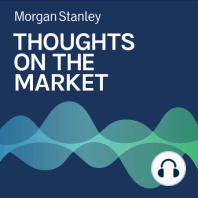3 min listen

Mid-Year U.S. Consumer Outlook: Spending, Savings and Travel
Mid-Year U.S. Consumer Outlook: Spending, Savings and Travel
ratings:
Length:
8 minutes
Released:
Jun 6, 2023
Format:
Podcast episode
Description
Consumers in the U.S. are largely returning to pre-COVID spending levels, but new behaviors related to travel, credit availability and inflation have emerged.----- Transcript -----Michelle Weaver: Welcome to Thoughts on the Market. I'm Michelle Weaver from the Morgan Stanley U.S. Equity Strategy Team. Sarah Wolfe: And I'm Sarah Wolfe from the U.S. Economics Team. Michelle Weaver: On this special episode of the podcast, we're taking a look at the state of the U.S. consumer as we approach the midyear mark. It's Tuesday, June 6th at 10 a.m. in New York. Michelle Weaver: In order to talk about where the consumer is right now, let's take it back two and a half years. It's January 2021, and households are slowly emerging from their COVID hibernations, but we're still months away from the broad distribution of the vaccine. Consumers are allocating 5% more of their wallet share to goods than before COVID, driving record consumption of electronics, home furnishings, sporting goods and recreational vehicles. All the things you needed to make staying at home a little bit better. Our U.S. economists at Morgan Stanley made a high conviction call in early 2021 that vaccine distribution would flip the script and drive a surge in services spending and a payback in goods spending. Sara, to what extent has this reversion played out and where do you think the U.S. consumer is now? Sarah Wolfe: The reversion is definitely played out, but there's been some big surprises. Basically, the spending pie has just been greater overall than expected, and that's thanks to unprecedented fiscal stimulus, excess savings and significant supply shortages. So we've not only seen a shift away from goods and toward services, but a much larger spending pie overall. The result has been a 13% surge in goods inflation over nearly three years, an acceleration in services inflation, and a return to pre-COVID spending habits that's much greater in real spending terms than in nominal terms. So if we look in the details, where has the payback been the largest? We've seen the biggest payback in home furnishing, home equipment, jewelry, watches, recreational vehicles, but we've seen the most robust recovery in discretionary services like dining out, going to a hotel, public transportation and recreational services. Michelle Weaver: Sara, has the recent turmoil in the banking sector affected the U.S. consumer and do you think there's a credit crunch going on right now? Sarah Wolfe: Bank funding costs have risen meaningfully and are expected to rise further, leading to tighter lending standards, slower loan growth and wider loan spreads. But let me be clear, this is not a credit crunch, nor do we expect it to be. We think about the pass through from tighter lending standards to the consumer to ways directly and indirectly. The direct channel is tighter lending standards for loans on consumer products, including credit cards and autos, and indirectly through tighter lending standards for businesses, which has knock-on effects for job growth. We've already seen the direct channel of consumer spending in the past year, as interest rates on new consumer loan products hit 20 to 30-year highs, raising overall debt service costs and forcing consumers to reduce purchases of interest sensitive goods. Dwindling supply of credit as banks tighten lending standards is also dampening consumption. Michelle Weaver: Great. And given that credit is getting a little bit tougher to come by, can you tell us what's happening with savings and what's happening with the labor market and labor income? Sarah Wolfe: This is very timely. Just a few days ago, we got a very strong jobs report for May. I think that this really supports our call for a soft landing, and even though consumers are increasingly worried about the economic outlook, about financial prospects, it's clear that we still have momentum in the economy and that the Fed can achieve its 2% inflation target without driving the unemployment ra
Released:
Jun 6, 2023
Format:
Podcast episode
Titles in the series (100)
Mike Wilson: Why Trade Tensions Are Only Part of the Story by Thoughts on the Market